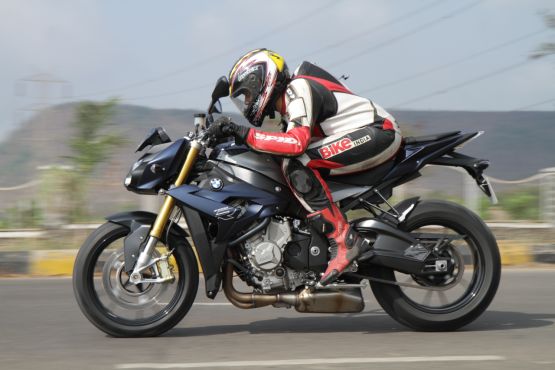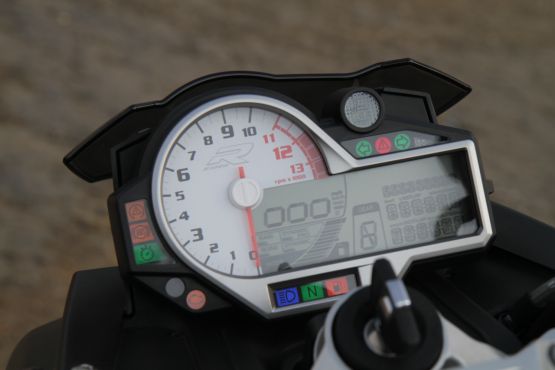
BMW have modified the S1000RR’s 999-cc in-line four engine to make it suitable for riding on public roads. It has a new cylinder-head, reduced compression ratio (12:1 from 13:1), reworked four-into-one exhaust and a revised fuel-injection system. The result is a 33 PS reduction in peak power output. The S1000R produces 160 PS at 11,000 RPM while the torque output remains unchanged at 112 Nm. However, it is generated 500 RPM lower at 9,250 RPM and BMW have used softer cams to modify the engine’s torque curve for better mid-range delivery.
Even with the reduction in engine performance, the S1000R is no slouch and with a kerb weight of 207 kg, it has a very good power-to-weight ratio. To tame the beast, BMW have equipped it with almost all of the high-tech electronic and mechanical riding aids they could think of. The bike we rode had a steering damper mounted under the headlamps, along with BMW’s Race ABS (anti-lock braking system) and ASC (automatic stability control). It also had a ride-by-wire throttle and a slipper clutch. The fabulous DDC (Dynamic Damping Control) system borrowed from the S1000RR’s HP4 version adjusts the damping every few milliseconds according to the road surface and also offers three fixed modes – Soft, Normal and Hard – that can be changed manually on the fly via a switch on the handlebar. The DTC (Dynamic Traction Control) ensures maximum traction on all types of road surfaces, prevents wheel spin and has a lean angle sensor for optimum throttle response when riding through a corner. The four riding modes – Rain, Road, Dynamic and Dynamic Pro – adjust the power delivery to suit the riding conditions. In Rain, the power output is reduced by about 30 PS and the throttle response is gentler. In Road, it is adapted to riding on dry public roads. Dynamic makes the throttle response even better while the Dynamic Pro unleashes the bike’s full potential. Apart from these, the S1000R also has a quick shifter for fast gear changes and, for some more money, they will also add a cruise control system adapted for motorcycles.
The bike feels even more compact from the saddle and the wide one-piece handlebar lends a sporty yet comfortable riding position. BMW have relaxed the posture further by lowering the foot-pegs compared to the S1000RR and the 814-mm saddle height should suit Indian riders of average height. After tinkering with the settings, I thumbed the two-into-one engine kill/ignition switch and, surprisingly, the engine came to life with the side-stand still down. The exhaust was humming as I rode the S1000R cautiously through the residential neighbourhood of Kharghar in search of a suitable place to test its capabilities. I slowed down to a standstill at the start of a straight stretch of road devoid of any traffic and shifted down to the first gear. Crouching on the tank, I change the suspension setting to hardest and switched to the Dynamic Pro mode.



Leave a Reply